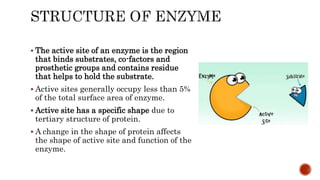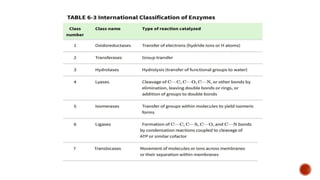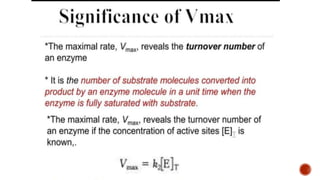This document discusses enzyme kinetics and the mechanisms of enzyme catalysis. It begins with definitions of key terms like enzyme and catalysis. It then describes classification of enzymes and the structure of active sites. The mechanisms of enzyme catalysis include acid-base, covalent, and metal ion catalysis. It also discusses models of enzyme-substrate binding like lock-and-key and induced fit. Kinetics concepts covered include Michaelis-Menten kinetics, Lineweaver-Burk plots, and factors affecting reaction rates like temperature and pH. Finally, it describes reversible and irreversible inhibition and different types of inhibitors.





























![ “It is an equation which describes how reaction velocity varies with
substrate concentration.”
Where
V0 is the initial reaction velocity.
Vmax is the maximum velocity.
Km is the Michaelis - Menten constant
[S] is the substrate concentration.](https://image.slidesharecdn.com/enzymes-231007152805-f43bcb7e/85/enzymes-pptx-30-320.jpg)







![ This form of the Michaelis-
Menten equation is called the
Lineweaver- Burk equation.
It is like linear graph equation
Y = mX + b
Graph is plotted against 1/[S] vs
1/V0](https://image.slidesharecdn.com/enzymes-231007152805-f43bcb7e/85/enzymes-pptx-38-320.jpg)





![ Uncompetitive inhibitors do not bind to the free enzyme. They bind only to the
enzyme-substrate complex to yield an inactive E. S. complex.
Uncompetitive inhibitors frequently observed in multi substrate reaction.
Inhibition can’t be reversed by increasing the [S] since I doesn’t compete with S for
the same binding site.](https://image.slidesharecdn.com/enzymes-231007152805-f43bcb7e/85/enzymes-pptx-44-320.jpg)



